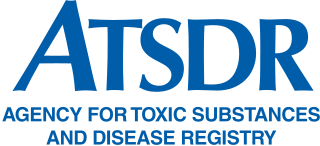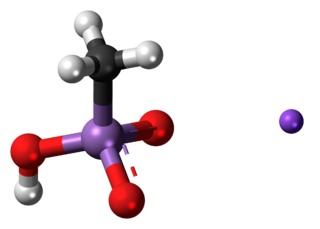
Hazardous waste is waste that has substantial or potential threats to public health or the environment.

Toxic waste is any unwanted material in all forms that can cause harm. Many of today's household products such as televisions, computers and phones contain toxic chemicals that can pollute the air and contaminate soil and water. Disposing of such waste is a major public health issue.

Environmental health is the branch of public health concerned with all aspects of the natural and built environment affecting human health. Environmental health is focused on the natural and built environments for the benefit of human health. The major subdisciplines of environmental health are: environmental science; environmental and occupational medicine, toxicology and epidemiology.

The Agency for Toxic Substances and Disease Registry (ATSDR) is a federal public health agency within the United States Department of Health and Human Services. The agency focuses on minimizing human health risks associated with exposure to hazardous substances. It works closely with other federal, state, and local agencies; tribal governments; local communities; and healthcare providers. Its mission is to "Serve the public through responsive public health actions to promote healthy and safe environments and prevent harmful exposures." ATSDR was created as an advisory, nonregulatory agency by the Superfund legislation and was formally organized in 1985.
Green chemistry, also called sustainable chemistry, is an area of chemistry and chemical engineering focused on the designing of products and processes that minimize or eliminate the use and generation of hazardous substances. While environmental chemistry focuses on the effects of polluting chemicals on nature, green chemistry focuses on the environmental impact of chemistry, including reducing consumption of nonrenewable resources and technological approaches for preventing pollution.
The Small Business Liability Relief and Brownfields Revitalization Act was signed into law by President George W. Bush on January 11, 2002. Brownfields are defined as, "A former industrial or commercial site where future use is affected by real or perceived environmental contamination." The Brownfields Law amended the Comprehensive Environmental Response, Compensation, and Liability Act by providing funds to assess and clean up brownfields, clarifying CERCLA liability protections, and providing funds to enhance state and tribal response programs. Other related laws and regulations impact brownfields cleanup and reuse through financial incentives and regulatory requirements.

The National Priorities List (NPL) is the priority list of hazardous waste sites in the United States eligible for long-term remedial investigation and remedial action (cleanup) financed under the federal Superfund program. Environmental Protection Agency (EPA) regulations outline a formal process for assessing hazardous waste sites and placing them on the NPL. The NPL is intended primarily to guide EPA in determining which sites are so contaminated as to warrant further investigation and significant cleanup.

Monosodium methyl arsenate (MSMA) is an arsenic-based herbicide. It is an organo-arsenate; less toxic than the inorganic form of arsenates. However, the EPA states that all forms of arsenic are a serious risk to human health and the United States' Agency for Toxic Substances and Disease Registry ranked arsenic as number 1 in its 2001 Priority List of Hazardous Substances at Superfund sites.

In the United States, an environmental site assessment is a report prepared for a real estate holding that identifies potential or existing environmental contamination liabilities. The analysis, often called an ESA, typically addresses both the underlying land as well as physical improvements to the property. A proportion of contaminated sites are "brownfield sites." In severe cases, brownfield sites may be added to the National Priorities List where they will be subject to the U.S. Environmental Protection Agency's Superfund program.
The California Department of Toxic Substances Control is an agency of the government of the state of California. The mission of the DTSC is to protect public health and the environment from toxic harm. DTSC is part of the California Environmental Protection Agency (Cal/EPA), has more than one thousand employees, and is headquartered in Sacramento. DTSC also has a number of regional offices across the state including two environmental chemistry laboratories, and field offices in Sacramento, Berkeley, Los Angeles, Chatsworth, Commerce, Cypress, Clovis (Fresno), San Diego and Calexico.
"Right to know", in the context of United States workplace and community environmental law, is the legal principle that the individual has the right to know the chemicals to which they may be exposed in their daily living. It is embodied in federal law in the United States as well as in local laws in several states. "Right to Know" laws take two forms: Community Right to Know and Workplace Right to Know. Each grants certain rights to those groups. The "right to know" concept is included in Rachel Carson's book Silent Spring.

Polychlorinated dibenzofurans (PCDFs) are a family of organic compounds with one or several of the hydrogens in the dibenzofuran structure replaced by chlorines. For example, 2,3,7,8-tetrachlorodibenzofuran (TCDF) has chlorine atoms substituted for each of the hydrogens on the number 2, 3, 7, and 8 carbons. Polychlorinated dibenzofurans are much more toxic than the parent compounds, with properties and chemical structures similar to polychlorinated dibenzodioxins. These groups together are often inaccurately called dioxins. They are known teratogens, mutagens, and suspected human carcinogens. PCDFs tend to co-occur with polychlorinated dibenzodioxins (PCDDs). PCDFs can be formed by pyrolysis or incineration at temperatures below 1200 °C of chlorine containing products, such as PVC, PCBs, and other organochlorides, or of non-chlorine containing products in the presence of chlorine donors. Dibenzofurans are known persistent organic pollutants (POP), classified among the dirty dozen in the Stockholm Convention on Persistent Organic Pollutants.
The Interagency Coordinating Committee on the Validation of Alternative Methods (ICCVAM) coordinates U.S. federal government evaluation of new, revised, and alternative test methods. Alternative methods are methods for safety testing of chemicals and chemical products that use fewer or no animals or that minimize or prevent animal pain and distress.
The Hazardous Substances Data Bank (HSDB) is a toxicology database on the U.S. National Library of Medicine's (NLM) Toxicology Data Network (TOXNET). It focuses on the toxicology of potentially hazardous chemicals, and includes information on human exposure, industrial hygiene, emergency handling procedures, environmental fate, regulatory requirements, and related areas. All data are referenced and derived from a core set of books, government documents, technical reports, and selected primary journal literature. All entries are peer-reviewed by a Scientific Review Panel (SRP), members of which represent a spectrum of professions and interests. Current Chairs of the SRP are Dr. Marcel J. Cassavant, MD, Toxicology Group, and Dr. Roland Everett Langford, PhD, Environmental Fate Group.

Radiation dose reconstruction refers to the process of estimating radiation doses that were received by individuals or populations in the past as a result of particular exposure situations of concern. The basic principle of radiation dose reconstruction is to characterize the radiation environment to which individuals have been exposed using available information. In cases where radiation exposures can not be fully characterized based on available data, default values based on reasonable scientific assumptions can be used as substitutes. The extent to which the default values are used depends on the purpose of the reconstruction(s) being undertaken.
In analytical chemistry, biomonitoring is the measurement of the body burden of toxic chemical compounds, elements, or their metabolites, in biological substances. Often, these measurements are done in blood and urine.
The California Green Chemistry Initiative (CGCI) is a six-part initiative to reduce public and environmental exposure to toxins through improved knowledge and regulation of chemicals; two parts became statute in 2008. The other four parts were not passed, but are still on the agenda of the California Department of Toxic Substances Control green ribbon science panel discussions. The two parts of the California Green Chemistry Initiative that were passed are known as AB 1879 : Hazardous Materials and Toxic Substances Evaluation and Regulation and SB 509 : Toxic Information Clearinghouse. Implementation of CGCI has been delayed indefinitely beyond the January 1, 2011.
Alternatives assessment or alternatives analysis is a problem-solving approach used in environmental design, technology, and policy. It aims to minimize environmental harm by comparing multiple potential solutions in the context of a specific problem, design goal, or policy objective. It is intended to inform decision-making in situations with many possible courses of action, a wide range of variables to consider, and significant degrees of uncertainty. Alternatives assessment was originally developed as a robust way to guide precautionary action and avoid paralysis by analysis; authors such as O'Brien have presented alternatives assessment as an approach that is complementary to risk assessment, the dominant decision-making approach in environmental policy. Likewise, Ashford has described the similar concept of technology options analysis as a way to generate innovative solutions to the problems of industrial pollution more effectively than through risk-based regulation.












